Investment opportunities
Anna Zamparo
2017-08-31T18:58:39+00:00
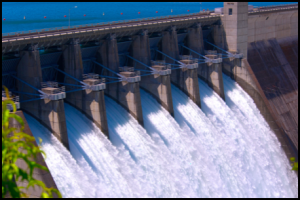
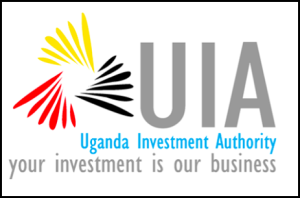

ENERGY
To date, the energy consumption in Uganda and within the East African regional market far outweighs its production and transmission, with a yearly growth rate of energy demand around 10%. The gap is wide and since less than 15% of Ugandan population has access to electricity, the development of an electricity grid within the country is a priority in the political agenda, as it widely influences also the social and economic development of the nation. The investment opportunities are huge: being Uganda a gateway in East Africa, it would be possible to export the surplus of the energy produced to the neighbor countries like South Sudan, Kenya, Tanzania, Rwanda and Congo.
 In 2000 the Government of Uganda established a new agency of the Ministry of Energy, Oil and Mineral Development, the Electricity Regulatory Authority (ERA), under section 4(1) of the Electricity Act (1999) to regulate the electricity industry in Uganda. The Act empowers ERA to issue for Generation, Transmission, Distribution or Sale of Electricity; establish a tariff structure and investigate charges, whether or not a specific complaint has been made for a tariff adjustment; approve the rates of charges and terms and conditions of electricity services provided by transmission and distribution companies, and develop and enforce performance standards for the generation, transmission and distribution of electricity, among others. For more information, visit http://www.era.or.ug/.
In 2000 the Government of Uganda established a new agency of the Ministry of Energy, Oil and Mineral Development, the Electricity Regulatory Authority (ERA), under section 4(1) of the Electricity Act (1999) to regulate the electricity industry in Uganda. The Act empowers ERA to issue for Generation, Transmission, Distribution or Sale of Electricity; establish a tariff structure and investigate charges, whether or not a specific complaint has been made for a tariff adjustment; approve the rates of charges and terms and conditions of electricity services provided by transmission and distribution companies, and develop and enforce performance standards for the generation, transmission and distribution of electricity, among others. For more information, visit http://www.era.or.ug/.
OIL AND GAS
The main area in which oil and gas exploration is taking place in Uganda is the Albertine Graben, which forms the northernmost part of the Western arm of the East African Rift Valley, along Uganda’s western border with the Democratic Republic of Congo. In the last 30 years Uganda’s government made efforts to promote the exploration of oil and gas in the country: the outcome is a total of 36,000 barrels of crude oil produced through extended well testing operations. In the medium to long-term, the government intends to develop a medium- to large-scale refinery to process the crude oil discovered so as to produce petroleum products for the country and to export it to the neighbour countries; the refinery will be developed on a Private-Public Partnership (PPP) basis through a joint venture company. Therefore, refinery-associated industries provide immense investment opportunities. These off-shoot industries include utilizing the refinery by-products, together with industries arising from the exploitation of natural gas.
RENEWABLE ENERGIES
Uganda has considerable unexploited renewable energy resources for energy production and provision of energy services, with an estimated potential of 5,300 MW. The goal of the Government Policy for the role of renewable energy in the national economy is to increase their exploitation from below 5% in 2007 up to 61% of the total energy consumption by 2017. The Ministry of Energy and Mineral Development is overseeing the development of the sector by formulating appropriate policies. More details are available on the website http://www.energyandminerals.go.ug/.
Hydro
Thanks to the presence of the Nile River and hundreds of minor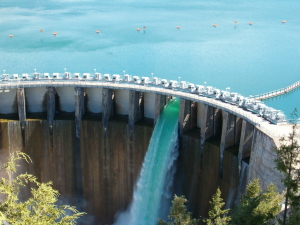 rivers, Uganda has considerable unexploited hydroelectric energy potential. Along the River Nile large hydropower projects could be developed, with an estimated potential of 2,000 MW. Besides, several minor spots have been already identified for the development of smaller hydropower projects. Nevertheless perspective investors are encouraged to scout for other potential sites, especially in the Mountain Elgon region and in the Western Districts.
rivers, Uganda has considerable unexploited hydroelectric energy potential. Along the River Nile large hydropower projects could be developed, with an estimated potential of 2,000 MW. Besides, several minor spots have been already identified for the development of smaller hydropower projects. Nevertheless perspective investors are encouraged to scout for other potential sites, especially in the Mountain Elgon region and in the Western Districts.
Solar
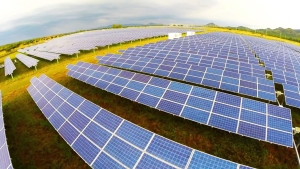 Rates of solar irradiation in Uganda are very high throughout the year. Indeed, existing data show that the country has a potential of 11.98 x 108 MVh gross solar energy resources. To date, the potential of solar photo-voltaic (PV) electricity is not sufficiently exploited to respond to the demand of the regional market. In order to increase diversity and security in electricity supply within the nation, one of the long-term policies of the Government is to develop small renewable projects to provide electricity, including the use of the solar photovoltaic.
Rates of solar irradiation in Uganda are very high throughout the year. Indeed, existing data show that the country has a potential of 11.98 x 108 MVh gross solar energy resources. To date, the potential of solar photo-voltaic (PV) electricity is not sufficiently exploited to respond to the demand of the regional market. In order to increase diversity and security in electricity supply within the nation, one of the long-term policies of the Government is to develop small renewable projects to provide electricity, including the use of the solar photovoltaic.
Geothermal
More than 40 geothermal sites in Uganda were studied for their energy potential; these studied revealed that three main areas for exploration are present: Katwe-Kikorongo, Buranga and Kibiro, all situated in or near the Western Rift Valley. According to the Renewable Energy Policy of Uganda in 2007, the potential geothermal energy from the three sites combined is about 450MW.
AGRICULTURE
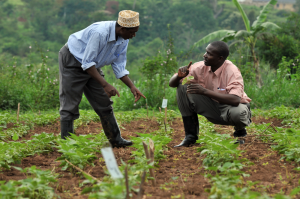 Uganda’s warm climate and fertile lands allow the agricultural sector to be dominant in the country’s economy. Indeed, the sector contributes 27,2% of the country’s Gross Domestic Product and employs over two-thirds of its workforce. Furthermore, Uganda is the leading producer of coffee, which contributes for 19% of the country’s exports; other cash crops are cotton, tea, cocoa and tobacco.
Uganda’s warm climate and fertile lands allow the agricultural sector to be dominant in the country’s economy. Indeed, the sector contributes 27,2% of the country’s Gross Domestic Product and employs over two-thirds of its workforce. Furthermore, Uganda is the leading producer of coffee, which contributes for 19% of the country’s exports; other cash crops are cotton, tea, cocoa and tobacco.
The Government is currently looking for partners to invest in scientific research in several branches, like for example disease-resistant seeds. Also scientific research in the livestock sector is proceeding at a slow rate due to a lack of financial supports.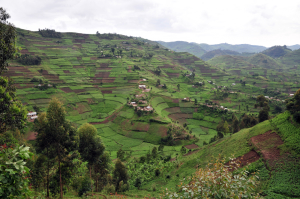 Investments in this sector would meet the demand for livestock and livestock products, which has been steadily increasing in the last decades within the East African region.
Investments in this sector would meet the demand for livestock and livestock products, which has been steadily increasing in the last decades within the East African region.
With regards to the fisheries sub-sector, expertise in fish-farming and fish processing is needed, as fish supplies in Uganda are currently dwindling (the Government has also created protected areas in lakes to avoid the capture of immature fishes), yet both internal and external demand for fish is growing. Therefore potentially profitable investment opportunities are present, like for example in the cage fish-farming industry.
More information available on the website of the Ugandan Ministry of Agriculture, Animal Industry and Fisheries: http://agriculture.go.ug/.
INFRASTRUCTURE
In recent years, Uganda has made great efforts in the development of infrastructures within the country. However, the deficit is still substantial, and investment opportunities exist in all national grids.
Despite reforms, the energy sector remains critical, as electrification rates are very low and distribution losses high. Therefore, substantial investments for the development of an adequate electricity network are needed, including power generation, transmission and distribution. Beside the energy sector, infrastructure needs include roads, railways and air transport, so to increase rural and urban connectivity, which in turn will also improve Uganda’s export competitiveness. Finally, proper sewage system and irrigation schemes are lacking in the country.
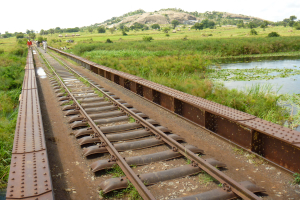 Most of the ongoing infrastructure projects in Uganda are funded through multi-pronged approaches that include the implementation of Public-Private Partnerships (PPPs) and financial resources from bi-lateral and multilateral institutions. Uganda already spends approximately $1 billion per year on infrastructure (about 11% of national GDP), but over the next decade an expenditure of around $1.4 billion per year is needed in order to address the country’s infrastructure challenges.
Most of the ongoing infrastructure projects in Uganda are funded through multi-pronged approaches that include the implementation of Public-Private Partnerships (PPPs) and financial resources from bi-lateral and multilateral institutions. Uganda already spends approximately $1 billion per year on infrastructure (about 11% of national GDP), but over the next decade an expenditure of around $1.4 billion per year is needed in order to address the country’s infrastructure challenges.
For more information, visit the official website of the Ugandan Ministry of Works and Transport: http://www.works.go.ug/.
MINING
Uganda’s Rift Valley contains rocks that are endowed with a variety of minerals, as evidenced by mining records. Also, new geo-data show that Uganda has great under-exploited mineral resources. These include deposits of gold, high trade tin, tungsten, salt, beryllium, cobalt, iron-ore, glass sand, uranium and other rare elements. Investment opportunities therefore exist in both mining and mineral processing.
In 2001 the Government of Uganda put in place a Mineral Policy whose main objectives are to stimulate investments by promoting private participation and to ensure that mineral wealth supports natural economic and social development. Furthermore, the Uganda Mining Act (2003) and Mining Regulation (2004) grant five types of mining rights: prospecting, exploration, retention, mining and location licenses.
Relevant information is available on the website of the Ugandan Ministry of Energy and Mineral Development www.energyandminerals.go.ug.
 In 2000 the Government of Uganda established a new agency of the Ministry of Energy, Oil and Mineral Development, the Electricity Regulatory Authority (ERA), under section 4(1) of the Electricity Act (1999) to regulate the electricity industry in Uganda. The Act empowers ERA to issue for Generation, Transmission, Distribution or Sale of Electricity; establish a tariff structure and investigate charges, whether or not a specific complaint has been made for a tariff adjustment; approve the rates of charges and terms and conditions of electricity services provided by transmission and distribution companies, and develop and enforce performance standards for the generation, transmission and distribution of electricity, among others. For more information, visit http://www.era.or.ug/.
In 2000 the Government of Uganda established a new agency of the Ministry of Energy, Oil and Mineral Development, the Electricity Regulatory Authority (ERA), under section 4(1) of the Electricity Act (1999) to regulate the electricity industry in Uganda. The Act empowers ERA to issue for Generation, Transmission, Distribution or Sale of Electricity; establish a tariff structure and investigate charges, whether or not a specific complaint has been made for a tariff adjustment; approve the rates of charges and terms and conditions of electricity services provided by transmission and distribution companies, and develop and enforce performance standards for the generation, transmission and distribution of electricity, among others. For more information, visit http://www.era.or.ug/. rivers, Uganda has considerable unexploited hydroelectric energy potential. Along the River Nile large hydropower projects could be developed, with an estimated potential of 2,000 MW. Besides, several minor spots have been already identified for the development of smaller hydropower projects. Nevertheless perspective investors are encouraged to scout for other potential sites, especially in the Mountain Elgon region and in the Western Districts.
rivers, Uganda has considerable unexploited hydroelectric energy potential. Along the River Nile large hydropower projects could be developed, with an estimated potential of 2,000 MW. Besides, several minor spots have been already identified for the development of smaller hydropower projects. Nevertheless perspective investors are encouraged to scout for other potential sites, especially in the Mountain Elgon region and in the Western Districts. Rates of solar irradiation in Uganda are very high throughout the year. Indeed, existing data show that the country has a potential of 11.98 x 108 MVh gross solar energy resources. To date, the potential of solar photo-voltaic (PV) electricity is not sufficiently exploited to respond to the demand of the regional market. In order to increase diversity and security in electricity supply within the nation, one of the long-term policies of the Government is to develop small renewable projects to provide electricity, including the use of the solar photovoltaic.
Rates of solar irradiation in Uganda are very high throughout the year. Indeed, existing data show that the country has a potential of 11.98 x 108 MVh gross solar energy resources. To date, the potential of solar photo-voltaic (PV) electricity is not sufficiently exploited to respond to the demand of the regional market. In order to increase diversity and security in electricity supply within the nation, one of the long-term policies of the Government is to develop small renewable projects to provide electricity, including the use of the solar photovoltaic. Uganda’s warm climate and fertile lands allow the agricultural sector to be dominant in the country’s economy. Indeed, the sector contributes 27,2% of the country’s Gross Domestic Product and employs over two-thirds of its workforce. Furthermore, Uganda is the leading producer of coffee, which contributes for 19% of the country’s exports; other cash crops are cotton, tea, cocoa and tobacco.
Uganda’s warm climate and fertile lands allow the agricultural sector to be dominant in the country’s economy. Indeed, the sector contributes 27,2% of the country’s Gross Domestic Product and employs over two-thirds of its workforce. Furthermore, Uganda is the leading producer of coffee, which contributes for 19% of the country’s exports; other cash crops are cotton, tea, cocoa and tobacco. Investments in this sector would meet the demand for livestock and livestock products, which has been steadily increasing in the last decades within the East African region.
Investments in this sector would meet the demand for livestock and livestock products, which has been steadily increasing in the last decades within the East African region. Most of the ongoing infrastructure projects in Uganda are funded through multi-pronged approaches that include the implementation of Public-Private Partnerships (PPPs) and financial resources from bi-lateral and multilateral institutions. Uganda already spends approximately $1 billion per year on infrastructure (about 11% of national GDP), but over the next decade an expenditure of around $1.4 billion per year is needed in order to address the country’s infrastructure challenges.
Most of the ongoing infrastructure projects in Uganda are funded through multi-pronged approaches that include the implementation of Public-Private Partnerships (PPPs) and financial resources from bi-lateral and multilateral institutions. Uganda already spends approximately $1 billion per year on infrastructure (about 11% of national GDP), but over the next decade an expenditure of around $1.4 billion per year is needed in order to address the country’s infrastructure challenges.
 Italiano
Italiano


